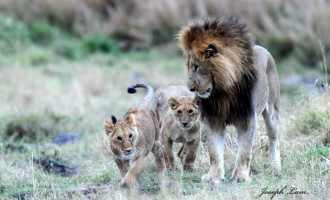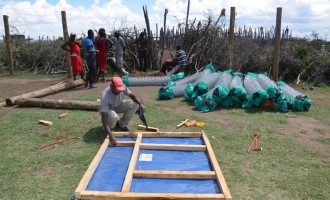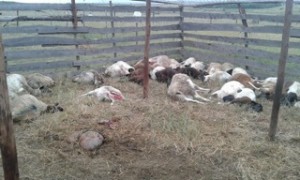There has been international outrage following widespread coverage by the media after a famous lion was killed by a hunter in Zimbabwe apparently just outside the boundary of a National Park.
Sport hunting for lions is prohibited in Kenya but we know how we would have felt if this had happened to any of our well-known lions, such as Lolparpit or Olbarnoti in Olare Motorogi Conservancy, or Saitoti, Saruni or Sadala in Ol Kinyei Conservancy, or Marti in Selenkay Conservancy or Mohawk or Cheru in Nairobi National Park.


In Kenya lion numbers are falling, not because of licensed sport hunting but due to two other big threats.
Kenya does not allow hunting of lions but we face other challenges. This week lions have just killed all the livestock of a sheep farmer outside Nairobi National Park, highlighting the difficulties of conserving and protecting lions when they come into conflict with ordinary people.
Kenya does not allow hunting of lions but we face other challenges. This week lions have just killed all the livestock of a sheep farmer outside Nairobi National Park, highlighting the difficulties of conserving and protecting lions when they come into conflict with ordinary people.
The main threats to our lions in Kenya are twofold: from habitat loss and human-wildlife conflict.
Without protected habitat in the form of large tracts of wilderness in which they can live and where there are abundant prey species, it will be difficult for lions to survive. So the parks, reserves and conservancies are vital as habitat for lions. In the face of an expanding human population which has increased from 8 million people at independence in 1963 to over 40 million today, these protected habitats can only continue in existence if they can pay their way and cover their running costs and up to now it has been mainly tourism that provides the income required to do this.
At Gamewatchers Safaris we have been involved in working with a number of partners and with local communities to expand the area of protected habitat for lions and other species through establishing conservancies in the Amboseli and Mara eco-systems where our Porini Camps offer a low-impact form of tourism generating the income to cover the conservancy running costs. In addition to the conservancies which we were involved in establishing in Amboseli and the Mara, we also have camps in the Ol Pejeta Conservancy and Nairobi National Park which also contribute to their running costs.
Within the 100,000 acres of Olare Motorogi, Naboisho and Ol Kinyei Conservancies which we were involved in establishing in the Mara, lion numbers have increased and there are now over 150 lions there. Similarly in Selenkay Conservancy we now have some of the highest numbers of lions in the Amboseli eco-system.


The second threat to lions is from human-wildlife conflict. When lions move beyond the boundaries of the parks, reserves and conservancies and into community lands, they may kill livestock which immediately causes a conflict with the people whose animals are killed. This can result in retaliation resulting in the deaths of lions through spearing or poisoning.
There are various programmes to mitigate this conflict between people and lions such as compensation schemes, or protection of livestock enclosures (“bomas”) through use of lion deterrent lights and strengthening of fencing to keep predators out. We have supported such measures and assisted in raising funds to strengthen bomas in the Mara and Amboseli as well as liaising and co-operating with other partners to do this.

This week we learned of an unfortunate incident just outside the Nairobi National Park, where we have our Nairobi Tented Camp. The Assistant Chief for the area, Nickson Parmisa, has informed us that lions broke into a livestock enclosure belonging to a local Maasai sheep farmer, Rupande Romo and killed all his 50 sheep, wiping out all his livestock and his entire livelihood and means of support.
This has the potential to cause great hostility by the local community towards the lions and Mr Parmisa is keen that there should be no retaliation. He would also like to see how Rupande Romo can be helped to replace his stock and to start again, combined with measures to make his livestock enclosure stronger so that it can withstand any future predation attempts by lions.




We have agreed to help by looking for donations from well-wishers towards replacing some of the 50 sheep (which cost Kshs 4,000 each, equivalent to US$40 or GB£27). We will start this off by donating a sheep from Gamewatchers Safaris as our contribution and if anyone wishes to support this by making a donation to help to buy a sheep for Rupande Romo and his family then we can receive this on his behalf and will hand this over to him once the livestock enclosure has been repaired and strengthened.
If you wish to help by contributing $40 to buy a sheep then please send an email to our CEO Jake Grieves-Cook confirming that you wish to do this (jake@gamewatchers.co.ke) and we will email you a link by return to make a secure online credit card payment to us.
We will list the names of all those who contribute and then hand over the donation of the sheep in the presence of the Chief to Rupande Romo. A report will be featured in our newsletter in due course with a list of all contributors.
Thank you to any who wish to support this initiative to reduce human-wildlife conflict!
Postscript:
As a result of the generous response to this appeal, we were able to help in replacing all the missing sheep for this family and some others and to install anti-predator lights on the livestock boma – click below for an update:
http://www.porini.com/blog/guest-donations-replace-livestock-killed-in-lion-attack/
As a result of the generous response to this appeal, we were able to help in replacing all the missing sheep for this family and some others and to install anti-predator lights on the livestock boma – click below for an update:
http://www.porini.com/blog/guest-donations-replace-livestock-killed-in-lion-attack/

